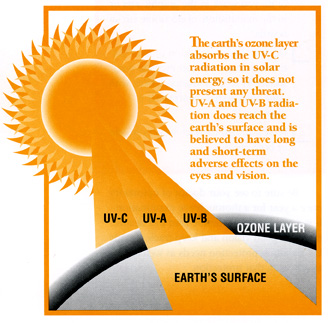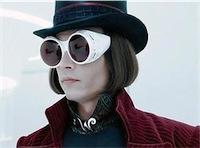Home > about eyes > Sunglasses and Radiation
Sunglasses and Radiation
What are UV Rays?
Ultraviolet rays can be subdivided into three different wavelength bands UV-A, UV-B, and UV-C. This is simply a convenient way of classifying the rays based on the amount of energy they contain and their effects on biological matter. UV-C is most energetic and most harmful; UV-A is least energetic and least harmful.
|
Luckily, UV-C rays do not reach the earth's surface because of the ozone layer. When UV-C rays meet the ozone molecules at high layers of the atmosphere, the energy inherent in them is enough to break apart the bond of the molecule and absorb the energy. Therefore, no UV-C rays from the sun ever come into contact with life on earth, though man-produced UV-C rays can be a hazard in certain professions, such as welders. UV-B rays have a lower energy level and a longer wavelength than UV-C. As their energy is often not sufficient to split an ozone molecule, some of them extend down to the earth's surface. UV-A rays do not have enough energy to break apart the bonds of the ozone, so UV-A radiation passes the earth's atmosphere almost unfiltered. As both UV-B and UV-A rays can be detrimental to our health, it is important that we protect ourselves. This can be done through a variety of ways. The most obvious is to reduce the amount of time one spends in the sun, particularly between the hours of 11 am and 3 pm, when the sun is at its highest in the sky. However, especially during the summer holidays, this does not always work out. |

Solar UV Radiation
|
Q. Should my children wear sunglasses?
A. Yes, if exposed to direct sunlight during the course of their day. Click here for some cool kids sunglasses.
The Australasian Radiation Protection and Nuclear Safety Agency (ARPANSA)
gives us the following information:
Health Effects of Solar UVR
Our skin and eyes are at risk from solar ultraviolet radiation (UVR). It is well known that over-exposure to UVR from the sun can cause sunburn, skin damage and, ultimately, skin cancer. Long term exposure to ultraviolet radiation can also cause cataracts, a clouding in the lens of the eye which obscures vision as well as short-term eye damage such as snow-blindness if the UVR intensity is sufficiently high.
Direct and Scattered Solar UVR
Good quality sunglasses (particularly, the “wrap-around” type) provide the eyes with substantial protection against solar UVR and are recommended for both children and adults. The important points to look for when purchasing sunglasses are detailed below.
Note: Sunglasses should not be worn at night, especially while driving, as they reduce visibility in an environment which already has low light levels. Click here for our online range of sunglasses.
When to Wear Sunglasses?
Wear sunglasses outdoors, particularly in the following circumstances:
- During Summer: The level of UVR at noon in summer can be more than three times as high as in winter. More importantly, the levels of UVB, the type of UVR that causes the most damage, can be as much as ten times higher (which is why sunburn takes such a short time in summer).
- Around noon: (1PM during daylight saving). Seventy percent of the harmful UVB radiation that is received each day occurs within three hours either side of this time.
- On the beach or boating: There are usually few buildings or structures to block the sun or sky, so people are exposed to direct and scattered radiation from the whole sky as well as reflections from water.
- Skiing at high altitude: Solar UVR increases with altitude and at 2000 metres (typical of Australian ski fields) can be as much as thirty percent higher than at sea level. The high reflectivity of snow worsens the problem, so that the UVR dose to the eye can be quite large. Consequently, good eye protection while skiing is very important.
Medical use of Sunglasses
Psoriasis patients undergoing PUVA therapy with UVR sources are extremely sensitive to UVA radiation for some time afterwards. They therefore require good eye protection and should wear sunglasses or goggles which absorb all of the UVR.
Sunglasses and Lenses
Sunglass lenses may be made from a variety of plastics such as acrylic or polycarbonate. Acrylic lenses are light, reasonably scratch resistant and generally tough enough for everyday use. Polycarbonate is usually optically superior to acrylic. Plastic lenses are light and impact resistant and the material is naturally UVR resistant. There are sunglass lenses made from glass which have excellent optical quality and are scratch resistant but they tend to be heavier and may shatter on impact.
Polarized lenses are also very popular as they reduce glare from many surfaces alleviating eye fatigue and eyestrain. Because they are effective at reducing glare, they may not be suitable for activities where high contrast must be discerned.
There are a number of coloured lenses available especially for fashion spectacles. Typical lenses for sunglasses have a dark tint. The amount of tint varies between products and the darker the lenses the more they reduce visible light.
It is the UVR-absorbing properties of the plastic that the lenses are made from that provides the protection and not the colouration of the lenses. This means that dark sunglasses are not necessarily more effective at protecting the eyes from UVR than lightly tinted sunglasses.
When choosing your sunglasses, consider the colour of the lenses. As a guide grey lenses provide a high degree of glare reduction and are suitable for bright light activities. Bronze lenses enhance contrast on hazy or overcast days and are suitable for everyday use. Other colours may offer other benefits.
A Standard for Sunglasses
In 2003 Standards Australia issued a joint Australian/New Zealand standard AS/NZS 1067:2003 Sunglasses and Fashion Spectacles, which sets limits on the allowed transmittances of fashion spectacles and sunglasses. All sunglasses sold in Australia must be labeled according to this standard.
Sunglasses meeting the standard are available in adults and children’s sizes. Wearing sunglasses that meet the standard’s requirements for effective sunglasses ensures your eyes have adequate protection against UVR damage.
The standard defines five categories of lenses:
| Lens category | Description | Additional markings |
|---|---|---|
| 0 | Fashion spectacles - not sunglasses very low sunglare reduction - some UVR protection | NONE |
| 1 | Fashion spectacles - not sunglasses limited sunglare reduction - some UVR protection | NOT SUITABLE FOR DRIVING AT NIGHT |
| 2 | Sunglasses - medium sunglare reduction and good UV protection | NONE |
| 3 | Sunglasses - high sunglare reduction and good UV protection | NONE |
| 4 | Special purpose sunglasses – very high sunglare reduction and good UV protection | MUST NOT BE USED WHEN DRIVING (Australian standard) |
|
|
Sunglasses that comply with the requirements of AS/NZS 1067 should be labeled to state this compliance. Sunglass lenses in lens category 4 must be marked with the prescribed symbol and the warning "MUST NOT BE USED WHEN DRIVING" required especially in Australia. |
 |
In addition to the AS/NZS 1067:2003 label several other markings may be found on sunglasses. Sunglasses labeled “EPF 10” (Eye Protection Factor rating 10) actually exceed the requirements of AS/NZS 1067. Sunglasses may also be labeled “Absorbs 100% UVR”. |
Sunglasses that are to be worn while driving must comply with the colouration limits of AS/NZS 1067. Colours, in particular traffic signals, will still be recognisable when viewed through the lenses.
Guidelines for purchasing sunglasses
- Check that the glasses are either sunglasses or special purpose sunglasses and not fashion spectacles.
- Check that the sunglasses carry a label that indicates they comply with or exceed the requirements of AS/NZS 1067:2003 or are rated EPF 10.
- If the glasses are to be used while driving, then check that colours are easily recognized when viewed through the lenses.
New Zealand OSH guidelines
In New Zealand, Health and safety regulations strongly advise the use of sunglasses between the hours of 11am and 4pm. This falls under the guidelines for protection from UV Radiation which also advises such measures as providing adequate clothing, sunscreen and cover where plausible.
'GUIDANCE NOTES FOR THE PROTECTION OF WORKERS FROM SOLAR UV RADIATION (1997)'
(NZ Department of Labour, Occupational Safety and Health Services - 1997)
tells us:
"...The Health and Safety in Employment Act 1992 requires employers to identify hazards faced by their employees and, if it is found that a hazard is significant, apply the hierarchy of actions — elimination, isolation and minimisation — to ensure that a significant hazard does not result in harm to employees......SunglassesUltraviolet radiation also adversely affects the eyes. Eye protection from UV radiation is essential for eye health, and eye shade is important for safety reasons in many outdoor jobs. Sunglasses meeting appropriate standards for protection can provide both.Sunglasses should meet AS1067:1990 and allow less than 5% UV-A transmission. Sunglasses should be worn by workers who work outdoors between 11 am and 4 pm.Some safety glasses now also offer adequate sun protection (etc.)...." |
 |
So if your staff are working outside in the sun, be sure to make them well aware of the risks involved of working directly exposed to sunlight, and be sure to provide adequate protection from the sun. Click here to check our range of reasonably priced sunglasses and safety glasses.
(for some more light reading from OSH click here) images on this page appear courtesy of google images & wikipedia.)





